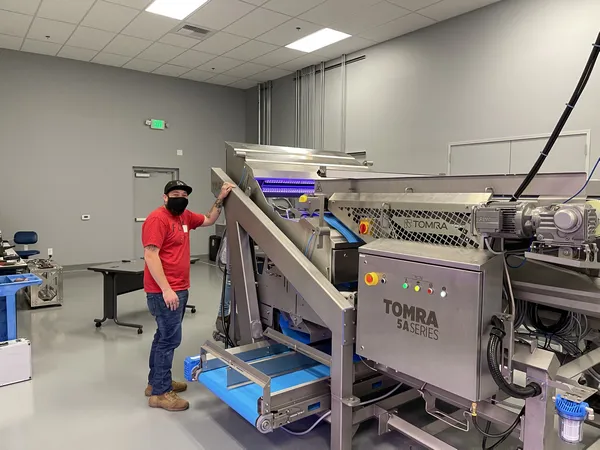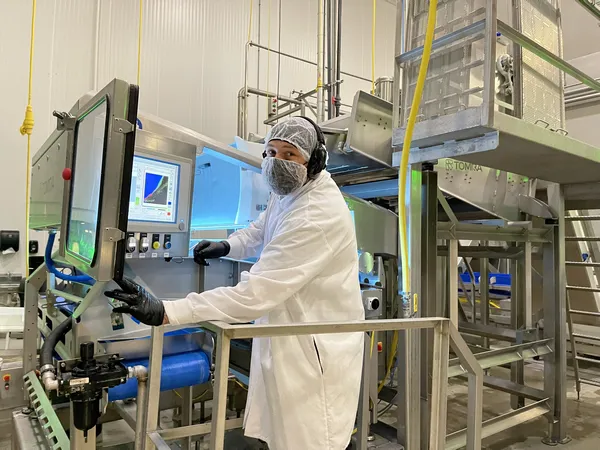As part of its commitment to digitalization to stay ahead of the competition, American agriculture and food business George Chiala Farms is one of many vegetable processors in the world to use the Tomra Insight data platform. TOMRA Insight has the potential to revolutionize food processing by gathering data from sorting machines which can be used instantly to optimize machine settings and retrospectively to take informed strategic business decisions.
GC Farms specializes in the production of prepared vegetable ingredients for well-known consumer brands whose products - such as soups, salsas, and frozen entrees - are sold throughout the USA. The business operates two processing plants, both in Central California. One is located in Hollister and the other, appropriately for such a forward-looking company, is in Morgan Hill on the edge of Silicon Valley, the global center for high technology and innovation.
GC Farms is a family-run business in the Santa Clara Valley whose origins go back to 1942, and which opened its first processing plant in 1984. The company operates two plants all year round, employing approximately 500 people and processing more than 120 million pounds (54 million kilograms) of vegetable ingredients annually. This throughput requires about 150 million pounds (68 million kilograms) of raw vegetables, some grown by GC Farms and some by third-party suppliers.

GC Farms’ Director of Operations, Charles Cutler, explains: “The quality of our raw materials can vary a lot, but the quality of what goes out to our customers has to be consistently high. To give our customers everything they ask for in quality, it is George Chiala Jr.’s vision to embrace digitalization, to be at the forefront of our industry.”
It is Cutler’s task to help turn the Chiala vision into reality. He observes: “As the industry moves toward ready-to-eat products, our customers’ quality expectations have gotten a lot higher. Quality used to mean assuring food safety. Now it’s about achieving product perfection. That’s why we have made a big shift in the last couple of years from manual sorting to automated sorting. This has taken our product quality to a higher standard, allowed us to reduce and stabilize our labor force, and reduced our labor costs for sorting on our Hollister line by 75 percent. And our customers like to know that we’re using TOMRA Food’s sorting technologies because it assures them that we’re doing the right things. It seems only logical to us to get even more from these machines by using Tomra Insight.”
Tomra Insight unlocks big gains
Tomra Insight gathers data in near real-time and stores this securely in the cloud so that it can be accessed from anywhere via web-based desktop and mobile devices. Because this data platform continuously measures the quality of the processing line’s material stream, operators can make prompt adjustments to machine settings in response to changes in material composition on the line. And because TOMRA Insight provides deep-dive data that wasn’t previously accessible, managers can now make operational and business decisions based on more complete information.
The potential value of this information is huge. Downtime can be reduced by monitoring machine health, supporting the management of predictive and condition-based maintenance, and preventing unscheduled machine shutdowns. Throughput variations can be evaluated to improve efficiencies - for example, a process manager might discover that by optimizing the sorter’s infeed it becomes possible to squeeze one more ton per hour over the sorter without impacting sorting quality. Cost can be reduced by minimizing waste and maximizing yield - and as GC Farms has found, for example, by being able to measure the quality of raw materials in order to agree a fair price for them. Quality can be improved - for example, if the percentage of defects is not in line with the agreed quality, the purchasing manager can work together with the grower to identify which defects were found and how to improve the quality of the next batches. And more immediately, data also offers businesses a competitive advantage at a day-to-day operational level, as GC Farms’ experience confirms.

Improving line rates and quality
GC Farms’ Morgan Hill plant currently utilizes two Tomra Sentinel II belt sorting machines and one Tomra 5A belt sorter. The Hollister plant also uses one Tomra 5A, plus one Genius belt sorting machine and one Blizzard free-fall machine. The company expects to install two new free-fall sorters, a Tomra 3C for the milling line in Morgan Hill and a Tomra 5C to replace the Blizzard, by the end of 2021. Cutler says, “We get a lot of extraneous material coming in from the fields that are out of our control, especially when growers use mechanical-harvesting rather than hand-harvesting. Tomra’s machines handle this well and have improved our quality grades tremendously.”
The three machines at Morgan Hill and the Tomra 5A at Hollister have so far been connected to Tomra Insight. This has put live access to machine data from both plants at George Cutler’s fingertips. And in the first few months of using TOMRA Insight, the Morgan Hill plant has already seen two big benefits. One is enhanced control over line rates, which optimizes line efficiency and throughput. The other is the ability to accurately assess the quality of incoming raw materials, which saves the company from paying over the odds when quality isn’t what it should be.
Cutler explains: “Whenever we’ve had a really bad batch of vegetables, we’ve been able to discuss this with our growers by sharing the Tomra Insight report. This ensures we pay a fair price for what we’re receiving, and it can help growers identify if there are any issues that they need to address to improve their processes and profitability.”
In addition to reporting defect composition percentages in charts, Tomra Insight also allows users to create reports specific to batches rather than a particular timeframe. To make it easier to access and view data, there will soon be an automated reporting feature that can specify the number of requirements to be reported on, the frequency of reports, and the email addresses to which they should be sent automatically.
What GC Farms likes most about Tomra Insight is the way it makes it possible to improve line efficiencies immediately. Cutler says: “It’s fantastic to see so much data about the quality of our raw product in real-time. And the way that the data is streamlined and filtered into an easy-to-read dashboard means that we can make decisions almost instantaneously. We’re now able to stabilize line rates so that what we’re putting into the sorter is optimized for everything on the line downstream. And anytime there’s any hint of issues with raw material, I immediately look at Insight data, often on my phone. This information shows whether we should make adjustments on the line, and then the data tells us whether those adjustments are working, rather than us having to guess or wait until the run is over to see what our yield is.
“I expected Tomra Insight to be useful, and over time it will become even more powerful because Tomra is regularly consulting users about their needs and adding new features and functionalities. Recent updates have included batch reporting; charts giving defect composition in percentages; conversions from imperial to metric weight unit, including weight expressed in pack numbers; and usability improvements that help us get even more out of our data.
“Even with more updates in the pipeline, TOMRA Insight has already exceeded my expectations. Seeing and acting on data is improving our line rates, our product quality, our yields, and our profitability.”
For more information:
Marijke Bellemans
Tomra Food
Tel: +32 (0)476 74 19 18
Email: [email protected]
www.tomra.com/food
